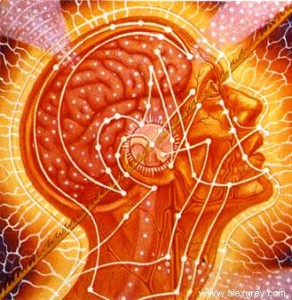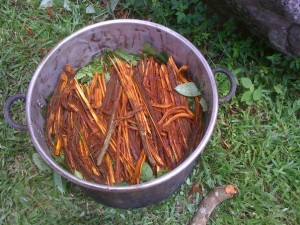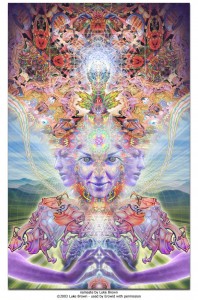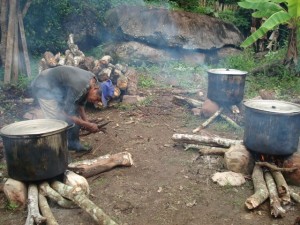The Nature of Things: A Strange Brew
 A Vancouver doctor, who’s treatment centre was found in the lower East-side of town, has spent much of the last several years treating his patients in that neighborhood, most of whom are hard-core Skid Row drug addicts. Finding himself frustrated with the way the Canadian drug laws and health care system treats his patients as criminals, rather than the emotionally and psychologically damaged souls that they are, Dr. Gabor Maté has turned to alternative means of treatment.
A Vancouver doctor, who’s treatment centre was found in the lower East-side of town, has spent much of the last several years treating his patients in that neighborhood, most of whom are hard-core Skid Row drug addicts. Finding himself frustrated with the way the Canadian drug laws and health care system treats his patients as criminals, rather than the emotionally and psychologically damaged souls that they are, Dr. Gabor Maté has turned to alternative means of treatment.
Dr. Maté has discovered through his work with these patients, that addictions are not necessarily caused by the inherent evils of toxic substances, such as narcotic drugs but could be considered instead as harmful behavioral patterns that we develop in our characters in order to hide from or to mask traumas that occurred during our childhood development. It is clear that without exception, the people who have become the junkie patients of Gabor’s East-side clinic have all led extraordinary lives, complete with many examples of sexual and physical abuse, neglect and emotional isolation experienced during their childhood periods.
 The link between childhood traumas and behavioral effects on the adults they become is widely supported in the medical literature, although it is not as readily accepted as a social explanation of addictions. During the development of the brain of an infant, many social interactions are required in order to develop and solidify the emotionally based behavioural patterns that make living in human society so unique. Also, because human babies are born with an extremely underdeveloped brain (the main limiting factor to be able to fit through the birth canal), the close emotional bonds that develop between it and its parent are necessary for the survival of such helpless infants in the early years of their brain growth. The development of our emotional and psychological systems are based on the growth of receptors that can transmit the social information via specific neurotransmitters among the myriad networks of neurons in our brains. Our incentive-motivation systems involve the use of dopamine circuits, the attachment-reward endorphin-based system involves the use of opioid circuits and our mood and impulse control systems involve serotonin circuits. Is it any wonder that deficiencies in these emotional systems, that should otherwise have developed through emotional bonds formed between a child and its parents, subject individuals to a susceptibility towards addiction when they are under-developed and can be compensated for by drugs such as cocaine, heroin and alcohol?
The link between childhood traumas and behavioral effects on the adults they become is widely supported in the medical literature, although it is not as readily accepted as a social explanation of addictions. During the development of the brain of an infant, many social interactions are required in order to develop and solidify the emotionally based behavioural patterns that make living in human society so unique. Also, because human babies are born with an extremely underdeveloped brain (the main limiting factor to be able to fit through the birth canal), the close emotional bonds that develop between it and its parent are necessary for the survival of such helpless infants in the early years of their brain growth. The development of our emotional and psychological systems are based on the growth of receptors that can transmit the social information via specific neurotransmitters among the myriad networks of neurons in our brains. Our incentive-motivation systems involve the use of dopamine circuits, the attachment-reward endorphin-based system involves the use of opioid circuits and our mood and impulse control systems involve serotonin circuits. Is it any wonder that deficiencies in these emotional systems, that should otherwise have developed through emotional bonds formed between a child and its parents, subject individuals to a susceptibility towards addiction when they are under-developed and can be compensated for by drugs such as cocaine, heroin and alcohol?
 Generally speaking, the neurons in the brain are wired during development, particularly early on in the life of the child, and these wiring patterns will control behaviors and emotions later on in the individual’s life, so if the brain is formed under the influence of negative emotions (stress, anxiety, depression) those patterns will be wired in to the ‘normal’ working of the brain. Happy emotional contact in babies and infants promotes the development of opioid and dopamine receptors by flooding brain with endorphins, and stress reduces the number of these receptors. So an individual with a deficient amount of opioid, dopamine and/or serotonin receptors in their brain will be highly susceptible to the cravings for these neurotransmitters that can be satisfied by drugs, as well as any intensely pleasurable activities to these people, such as sex, shopping or gambling, hence the basis for chemical or behavioral addictions.
Generally speaking, the neurons in the brain are wired during development, particularly early on in the life of the child, and these wiring patterns will control behaviors and emotions later on in the individual’s life, so if the brain is formed under the influence of negative emotions (stress, anxiety, depression) those patterns will be wired in to the ‘normal’ working of the brain. Happy emotional contact in babies and infants promotes the development of opioid and dopamine receptors by flooding brain with endorphins, and stress reduces the number of these receptors. So an individual with a deficient amount of opioid, dopamine and/or serotonin receptors in their brain will be highly susceptible to the cravings for these neurotransmitters that can be satisfied by drugs, as well as any intensely pleasurable activities to these people, such as sex, shopping or gambling, hence the basis for chemical or behavioral addictions.
 Recognizing that addictions may be rooted in psychological traumas, Dr. Maté has become interested in the potential use of Ayahuasca, an Amazonian brew, as a treatment for addictions, due to its powerful ability to access difficult or repressed memories in the individuals under the influence of its profoundly psychaedelic effects. He has learned of a rehab clinic down in Tarapoto, Peru known as Takiwasi (meaning ‘the house that sings’) that is treating addiction patients using Ayahuasca among other Amazonian plant cures, with a success rate that is triple the North American average.
Recognizing that addictions may be rooted in psychological traumas, Dr. Maté has become interested in the potential use of Ayahuasca, an Amazonian brew, as a treatment for addictions, due to its powerful ability to access difficult or repressed memories in the individuals under the influence of its profoundly psychaedelic effects. He has learned of a rehab clinic down in Tarapoto, Peru known as Takiwasi (meaning ‘the house that sings’) that is treating addiction patients using Ayahuasca among other Amazonian plant cures, with a success rate that is triple the North American average.
 We ventured down to Peru last March in order to visit the Takiwasi clinic run by French Dr. Jacques Mabit, the once Doctors-without-Borders intern turned Amazonian shaman (cuandero), to witness first-hand the powerful effects of the plants used in the process of healing the Amazonian way.
We ventured down to Peru last March in order to visit the Takiwasi clinic run by French Dr. Jacques Mabit, the once Doctors-without-Borders intern turned Amazonian shaman (cuandero), to witness first-hand the powerful effects of the plants used in the process of healing the Amazonian way.
 Ayahuasca, also known as yagé, hoaca, vegetal and several other names, is a mixture of a plant containing N,N-dimethyl-tryptamine or DMT and a vine containing mono-amine oxidase inhibitors (whose relative roles in the mixture will be made clear below). The traditional ingredients for this brew are the DMT containing ‘chacruna’ plant (Psychotria viridis) and the B-Carboline alkaloids that act as MAO-inhibitors come from the Ayahuasca vine (Banisteriopsis caapi) but many other species have been used in creating similar mixtures that are known a ‘Ayahuasca analogs’.
Ayahuasca, also known as yagé, hoaca, vegetal and several other names, is a mixture of a plant containing N,N-dimethyl-tryptamine or DMT and a vine containing mono-amine oxidase inhibitors (whose relative roles in the mixture will be made clear below). The traditional ingredients for this brew are the DMT containing ‘chacruna’ plant (Psychotria viridis) and the B-Carboline alkaloids that act as MAO-inhibitors come from the Ayahuasca vine (Banisteriopsis caapi) but many other species have been used in creating similar mixtures that are known a ‘Ayahuasca analogs’.
 DMT is s powerful mimic of the hormone and neurotransmitter serotonin, much like those found in the other psychaedelics such as LSD, magic mushrooms, peyote and mescaline. However, the serotonergic effect of DMT is particularly strong in the mood and memory receptors of the brain, due to a strong affinity for four subtypes of the 5-HT2 serotonin receptors. Because of this behavior of DMT in the brain, the effect of the psychaedelic on the perception of an individual under its influence involves a hyper-sensitization to emotions and hallucinations in the visual and auditory spheres.
DMT is s powerful mimic of the hormone and neurotransmitter serotonin, much like those found in the other psychaedelics such as LSD, magic mushrooms, peyote and mescaline. However, the serotonergic effect of DMT is particularly strong in the mood and memory receptors of the brain, due to a strong affinity for four subtypes of the 5-HT2 serotonin receptors. Because of this behavior of DMT in the brain, the effect of the psychaedelic on the perception of an individual under its influence involves a hyper-sensitization to emotions and hallucinations in the visual and auditory spheres.
However, our bodies contain endogenous mono-amines that play many hormonal roles in the regulation of metabolism in the gut, as well as neurotransmitter-regulated mood impulses in the brain. Furthermore, our food contains many alkaloids and other nitrogen containing compounds, therefore, our bodies are equipped with enzymes whose role it is to naturally breakdown the mono-amine chemicals found endogenously in our bodies (such as serotonin and dopamine), as well as those that find their way in through our food. These enzymes, known as mono-amine oxidases are ubiquitous in the gut and render the oral ingestion of DMT or any other mono-amines ineffective, as they are quickly broken down before they can pass the blood-brain barrier and have any psychoactive effects. The only way to make a DMT-containing plant orally active is to combine it with another plant that contains MAO inhibitors, thus shutting down the body’s natural regulator enzymes of the hormones and neurotransmitters.
 Amazingly, the indigenous people of the Amazon basin have known about combinations of plants for thousands of years that contain not only DMT but also the MAO inhibitors that allow them to be orally active in an infused preparation. With tens of thousands of plant species to sample in that biodiverse tropical region and no biochemistry labs to extract and confirm the presence and identity of biologically active plant compounds, it is nothing short of short of astounding that the recipes for Ayahuasca and its analogs even exist! This not only applies credence to the wealth of ethnobotanical knowledge that exists in indigenous cultures, but also the need to urge for biological conservation in the tropics for the potential drugs and cures that may never otherwise be discovered if those biodiversity resources are lost.
Amazingly, the indigenous people of the Amazon basin have known about combinations of plants for thousands of years that contain not only DMT but also the MAO inhibitors that allow them to be orally active in an infused preparation. With tens of thousands of plant species to sample in that biodiverse tropical region and no biochemistry labs to extract and confirm the presence and identity of biologically active plant compounds, it is nothing short of short of astounding that the recipes for Ayahuasca and its analogs even exist! This not only applies credence to the wealth of ethnobotanical knowledge that exists in indigenous cultures, but also the need to urge for biological conservation in the tropics for the potential drugs and cures that may never otherwise be discovered if those biodiversity resources are lost.
The fact that these experiences are largely undocumented and poorly explained by science does not imply that it should be considered as some kind of magic or divinity. It is clear that there is a potential for Ayahuasca and its psychaedelic visions to play an important role in studying how the brain deals with trauma and addictions once there is a greater understanding of its modes and mechanisms and how they relate to the brain’s own biochemistry of synapses, receptors and neurotransmitters.
Many scientific predictions of the past have been found out to be true but were unavailable for analysis until the sophistication of the tools became more advanced: Darwin didn’t know about the genetic mechanisms of natural selection but suggested that there were some kind of ‘particles of inheritance’ and he was later found out to be right. Einstein proposed the theory of relativity before the tools were available to confirm or deny it, but once the technology was developed, he was shown to be right. Perhaps one day we will be able to scientifically describe the exact mechanisms this so-called ‘magic’ effect of these plants on the sub-conscience and will be able to be demonstrated once we have the ability to observe and to measure it empirically.
 One major obstacle to progress in the study of using psychaedelics in psychotherapy treatments is in the drug laws of most jurisdictions that ban the research and use of these substances due to their classification as hardcore narcotics. Despite the fact that all evidence points to significantly positive effects on the psychology of users of psychaedelics, many countries, including Canada continue to prohibit the use of many plant-based drugs on the myopic and unfounded basis that they are harmful to the users or to those around them.
One major obstacle to progress in the study of using psychaedelics in psychotherapy treatments is in the drug laws of most jurisdictions that ban the research and use of these substances due to their classification as hardcore narcotics. Despite the fact that all evidence points to significantly positive effects on the psychology of users of psychaedelics, many countries, including Canada continue to prohibit the use of many plant-based drugs on the myopic and unfounded basis that they are harmful to the users or to those around them.
Ironically, the potential for treating drug addicts with psychedelics like Ayahuasca is a double-edged sword: on the one hand, we are de-stigmatizing the drugs that are fueling their personal problems by allowing them to run away from their true root causes, the psychological ones associated with trauma and, on the other hand, a key component to the proposed solution involves taking another substance that the government considers equally as bad as the first.
You can see some of the clips of scenes that I filmed in Peru last March of 2010 on this page here. The show is on air Thursday November 10 at 8pm (2010) on CBC television. You can watch the episode online at this link here or find it through The Nature of Things’ website here.


